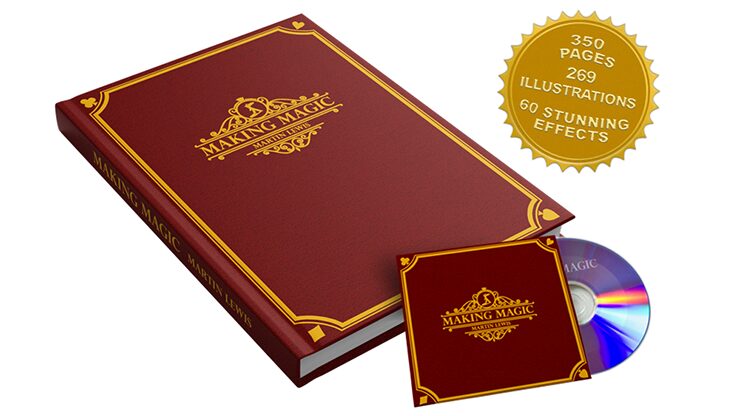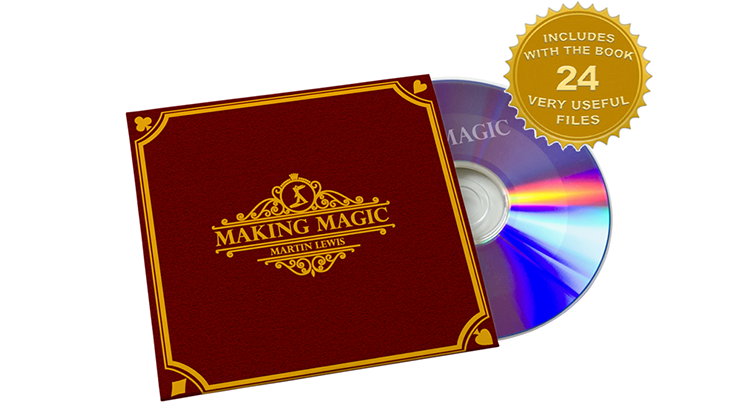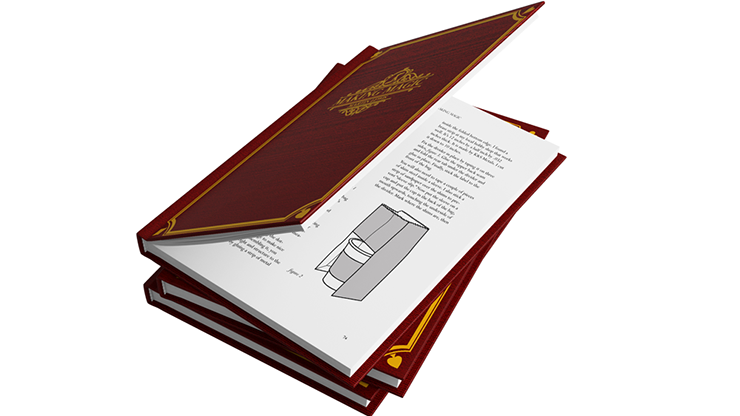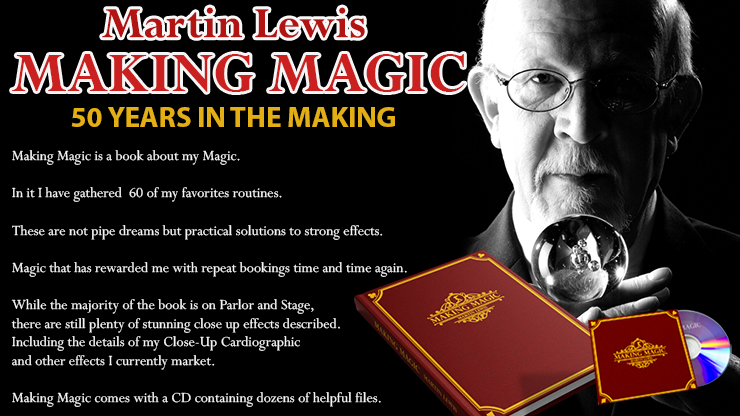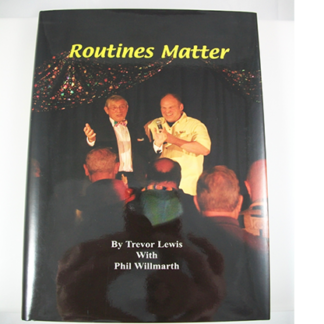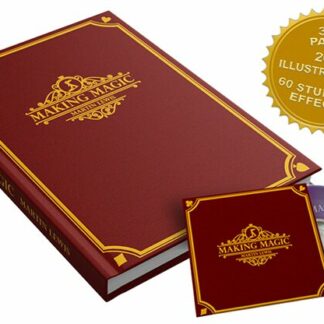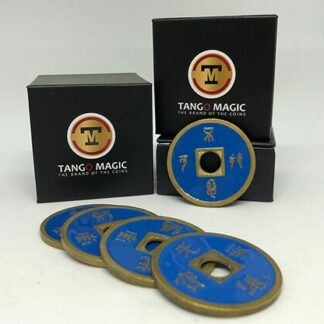Description
Making Magic is a book about my magic. In it I have gathered together 60 of my favorites routines. These are not pipe dreams but practical solutions to strong effects. Magic that has rewarded me with repeat bookings time and time again. While the majority of the book is on parlor and stage, there are still plenty of stunning close up effects described. Including the details of my close-up cardiographic.
Making Magic contains material from my notebooks, lectures, magazine articles, videos, and marketed tricks. Since my magic is constantly evolving everything has been re-written to bring it all up to date.
REVIEWS:
“Making Magic is the kind of book that the magic world does not see often; It aims high and exceeds its goal. Packed full of high quality routines, the writing and illustrations are exceptional.
When you catch the subtle word play in the title of the book you realize that much of the material requires a little construction and handiwork is required to bring the routines into being. That’s why the writing and illustrations are so important. I am not much of a “do it yourself” guy, but Lewis guides you with a quiet expertise.
The tricks themselves are high quality and very commercial, with many of them direct from Martin’s act or his companies roster of marketed effects. There is even a separate disc that contains the templates and extra information that you will need to construct Martin’s latest miracles.
I heartily recommend this book and think it is destined to become a contemporary classic of magic. It is a wonderful example of how magic, method and the way they are taught can coalesce into something really special.”
– Nick Lewin – Vanish International Magic Magazine
“Making Magic is a treasure chest of practical, commercial, and baffling routines for both stage and close-up. Every bit of vital information is explained, including artwork and construction diagrams, handling details, and Martin’s witty presentations. It is one of the finest resources for this type of material I’ve ever seen, and is a bargain at the price.
I could probably just stop here; at this point you pretty much know everything you need to know to make an intelligent purchasing decision, but I’ll fill in a few more details.
Sixty effects are explained in Making Magic; thirty-seven are stand-up routines. If you’ve ever tried to put together a stand-up show, you quickly realize there is a dearth of great stand-up material. This is why so many performers use the same routines. In Martin’s book you’ll find fresh approaches to some classic plots (for example, Playing with Your Food, Martin’s take on the Mental Epic effect). Yes, you’ll have to spend a little time (and/or money) to construct the props, but if you do so, you’ll have some great routines not many others are performing.
Finally, there are some great stories. Martin was fortunate to have been on the West Coast during the golden years of the Magic Castle; his reminiscences of those times are scattered throughout the book. In particular, the stories of Vernon and the pool table, Lou Derman and the greatest card trick ever performed, and Harry Anderson and the animal trap are personal favorites.
So here’s the bottom line: if you do stand-up magic (whether or not you’re a do-it-yourselfer) you need this book. If you’re looking for close-up magic that won’t bust your chops, you need this book. Or if you’re just interested in seeing how one of magic’s premier creators designs his miracles, you need this book. For what you get, the price is ridiculously low. Making Magic is one of the best magic books I’ve ever read. Buy it; you won’t regret it. It has my highest recommendation.”
– Michael Close
“I wanted to let you know how much I love Martin’s last book. Nearly every sentence has some incredible insight. I can only handle a chapter a day because they’re all packed with so much wonderful information to absorb.
I also cannot count how many times I’ve laughed out loud at Martin’s comedic lines in the explanations and scripts. A joy.”
– Todd Karr
“Martin Lewis has amazed and entertained me over the course of what seems like countless years now. But as mystifying and entertaining a magician as Martin is, he has often most greatly mystified and amazed me in his lectures, when explaining a seemingly endless faucet of inventive creativity, matched with a remarkable talent for constructing ingenious but often easily built magic props. All of these talents are on spectacular display in the pages of Making Magic, along with a wealth of original stand-up magic that can help any reader to construct a more original and distinctive act.
The man who created “Cardiographic” presents readers with an inspired volume brimming with similarly deceptive, original and commercial effects. Are you a worker? Want to be a worker? Want to stand out from the crowd? “Making Magic” will show you how, with step-by-step instructions, downloadable support materials, and all presented in Martin’s witty and engaging voice, littered with great anecdotes gathered over the course of a remarkable career. Did I like “Making Magic”? No – I loved it!”
– Jamy Ian Swiss
“Everyone knows Martin Lewis because he created the modern classics “Sidewalk Shuffle” and “Cardiographic.” Winning the Academy of Magical Arts awards for Parlour Magician of the Year in 2000 and 2001 and Lecturer of the Year in 2005 and 2007 doesn’t hurt either.
When he isn’t creating, performing, and marketing his strong, fun, commercial magic, Mr. Lewis haunts all of the hardware and arts and crafts stores within a 10-mile radius of his clandestine California compound. Guileless grist for his magical mill.
In Making Magic, Mr. Lewis teaches 60 of his best magic creations culled from his lectures, magazine contributions, videos, marketed tricks, and notebooks. Most of the effects employ small props and are designed to be performed in a parlor or stage setting. Thankfully, the author includes some cunning close-up material as well. Mr. Lewis rewrote all of the previously published material to bring it up to date.
The author writes well, is impishly funny and does a fine job of teaching his material. He provides appropriate attribution. Mr. Lewis intersperses the effects with ripping yarns from his life in magic. The illustrations are fetching and nicely complement the text.
To perform an entertaining show, Mr. Lewis rates personality as the most important factor, followed by presentation, effect, and finally method. For that reason, most of the effects include his presentation or engaging script.
The book is beautifully designed and produced. Mr. Lewis includes a CD containing dozens of files of attractive artwork and clear plans needed for the construction of the props. Yes, I said construction of the props.
The book’s title is literal. To perform most of the effects in this book, you must make the magic props. Now, don’t start whining or stop reading! Apart from a few props that require special material and professional construction, the construction of the props isn’t difficult. You don’t need special skills. You do need to follow Mr. Lewis’s clear directions carefully.
The materials consist of card stock, wood or plastic. You don’t need many tools other than a ruler, X-Acto knife, screwdriver, and hammer. You’ll be surprised by how quickly and easily you’ll create a magic prop that looks either very attractive or blandly normal.
I like or love most of the material in Making Magic. Here are some of my favorite effects.
“Threesome” is Mr. Lewis’s eye-popping version of Robert Harbin’s “Card in Bottle.” The performer displays three small, clear bottles. Three audience members each select a card. The performer seals the cards in an envelope which is initialed. A selection visibly appears in each bottle. The performer tears up the envelope, proving that the three cards are gone.
“Coupons” is a torn and restored effect using a page of coupons from a newspaper. Mr. Lewis’s clever method allows you to end clean and immediately hand out the restored page.
In “Human Brain Vivisection,” the performer invites a participant on stage and kills him by plunging two daggers into his head. The sobbing, babbling performer is dragged off stage. This is my new kid show closer!
Mr. Lewis teaches you how to birth his baby, “Cardiographic.” “Cardiographic Lite” is even better. It’s a smaller version of the original, featuring a quicker, easier reset. In “Crystal Gazing,” the performer displays a deck of jumbo cards to a participant. She looks away while the audience selects one of the cards. The performer displays a crystal ball. The participant gazes into it and slowly divines the identity of the card. Ricky Jay was so smitten with Mr. Lewis’s “One Hand Spin and Catch” that he included it in Cards as Weapons. I’ve performed this fab flourish since I bought the book when I was 17. The author teaches how to make giant cards and perform his exquisite “Sidewalk Shuffle.” In “Strongbox” a participant calls off the last three serial numbers of her dollar bill and signs it. The performer places the bill into a handkerchief, which is held by the participant. She is given a steel cash box, with a combination lock to hold in her other hand. Her bill vanishes from the handkerchief. The last three numbers of her bill are the combination that opens the cash box. Inside, she finds a Bill Tube. She opens it and discovers her signed bill.
“Golf” is an Egg Bag routine performed with a golf ball. For the kicker, the performer removes a golf club from the small bag. Mr. Lewis’s design for creating “The Tarbell Bag” is better than the instructions published in the Tarbell Course in Magic.
“Undivided” is Mr. Lewis’s beautiful torn and restored cigarette paper. David Copperfield liked it enough to feature it on one of his TV specials.
“Close-up Cardiographic” measures three by five inches, employs a different propulsion system than its grandpappy, and features the quick reset feature.
In “Magician’s Poker,” “Triumph” breeds with “McDonald’s Aces” and their offspring is this strong, commercial poker routine.
In “Teletop,” a participant freely selects an ESP symbol and places it aside without looking at it. The performer introduces a small, wooden spinning top, and a board decorated with ESP symbols. He spins the top on the board. The top circles the board and comes to rest on the selected symbol.
“Sidewalk Shuffle Straight” employs three duplicate, poker-size Aces and a blank-face card.
Martin Lewis is a creative treasure and this is a wonderful book. Performing an effect with a prop that you’ve created with your own hands provides an added feeling of satisfaction that you cannot otherwise experience. That sublime sensation more than justifies the one-time effort needed to build the prop. So seize this opportunity to become a Martha Stewart of magic, a DIY diva of deception! Buy the book, wield your tools, and start Making Magic.
Highly Recommended.”
– Tom Frame– Genii Magazine

